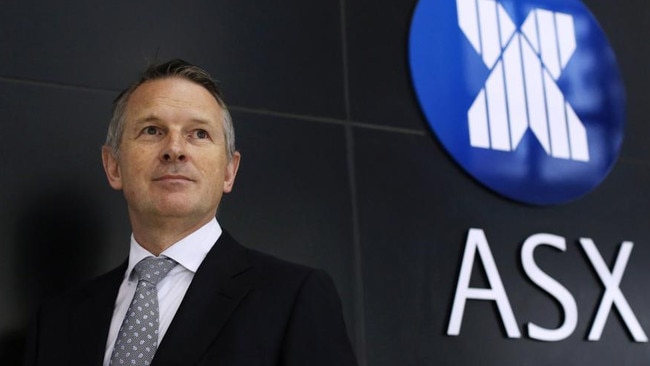ASX strips former CEO Dominic Stevens of bonus payments
Former ASX Ltd boss Dominic Stevens has had more than $3.14m in long-term bonus payments axed following a botched technology upgrade.
Former ASX Ltd boss Dominic Stevens has had more than $3.14m in long-term bonus payments axed and the exchange operator’s executive team also took a haircut after a botched technology upgrade attracted a stinging rebuke from regulators.
Mr Stevens left the ASX last year with the much-delayed tech upgrade still in train.
On taking charge, new CEO Helen Lofthouse ordered a review of the CHESS project that was to be built around an untested blockchain technology and then just weeks later shelved it entirely. That has put the ASX years behind in its plan to replace its ageing settlements platform.
After the former CEO left, the board decided to strip Mr Stevens of 52,175 long-term performance rights he was issued between 2018 and 2021. This was worth $3.14m at current market rates.
The move was due to “the pause to the CHESS replacement project and the impact the delay had on our customers and other stakeholders,” the ASX said in its annual report. The former CEO also lost all of his short-term variable payments for 2019 and 2020.
Other executives still at ASX and directly accountable for the CHESS program before November 2022 had their bonus payments slashed or cut entirely.
“In FY23, following the external review into aspects of the CHESS replacement project and the announced return to solution design, the board has determined that further remuneration consequences be applied under ASX’s Consequence Management Framework and in line with ASX’s Remuneration Adjustments Policy,” the ASX said.
It came as ASX. reported a 38 per cent fall in its net profit after tax to $317.3m for the year ended June 30, in line with expectations. Underlying profit fell 3.4 per cent to $499.3m as operating revenue fell 1.2 per cent to $1.01bn and expenses rose 12 per cent to $374.6m.
ASX revenues are set to benefit from a peak in interest rates as inflation cools, reinforcing a positive outlook for the exchange operator after resetting its CHESS replacement project.
Ms Lofthouse hailed the “resilience” of ASX’s earnings amid “challenging market conditions” and previously disclosed technology costs relating to the replacement of CHESS.

“In one of the fastest tightening monetary cycles on record, with geopolitical tension and lower equity trading volumes, ASX has delivered a resilient underlying financial result,” Ms Lofthouse said. “This is the second time the group has achieved a full-year operating revenue performance of over $1bn, underscoring the strength of our diversified business model.”
ASX expects reduced inflationary pressures and growing confidence around the peak for interest rates should be positive for cash market trading volumes.
New capital management settings announced in June, including plans to raise $200m-$300m from a corporate bond issue in the September quarter, will allow ASX to modernise CHESS and risk management systems and also give it flexibility to pursue “growth opportunities”.
Compared to its global peers, ASX has consistently ranked in the top 10 for IPO offers. In the past five years, it has executed an annual average of more than 130 new listings, raising $7bn.
“While we’ll continue to look at domestic listing opportunities, we’ll also be executing a targeted offshore strategy, focusing on industries and geographies where ASX has a compelling value proposition,” said Ms Lofthouse, noting New Zealand and the US as priorities.
“We’ll also continue to develop and grow the ecosystem of corporate and investment product issuers through engagement and education programs to reinforce the attractiveness of our offering – with the goal of getting Australian companies to choose ASX as their listings venue.”
Cash market average daily volume was broadly in line with pre-pandemic levels, and ASX sees a “solid pipeline” of corporates considering listing here as conditions improve.
Citi analyst Nigel Pittaway said ASX’s underlying net profit was 2 per cent below consensus, mainly due to softer than expected revenue, particularly in securities and payments, where the number of CHESS holding statements issued fell significantly, and primary market facilitation services dropped.
“ASX’s focus seemingly remains on appeasing regulators and other stakeholders and modernising its technology,” he said.
ASX reiterated FY24 expense growth guidance of 12-15 per cent, with an operating expense review underway.
Capital expenditure is expected to be between $110m and $140m in the 2024 financial year, driven by investment in technology modernisation, and supported by the proposed launch of a corporate bond of between $200m and $300m in the first quarter of the 2024 financial year.
ASX revealed no new material update on its CHESS replacement project in its report, saying that it continues to work towards announcing the solution design in the December quarter.
The group will pay a final dividend of $1.12 a share, taking its total for the 2023 financial year to $2.28. That’s down 3.4 per cent from a year earlier. ASX shares closed down 1.9 per cent at $60.50.








To join the conversation, please log in. Don't have an account? Register
Join the conversation, you are commenting as Logout